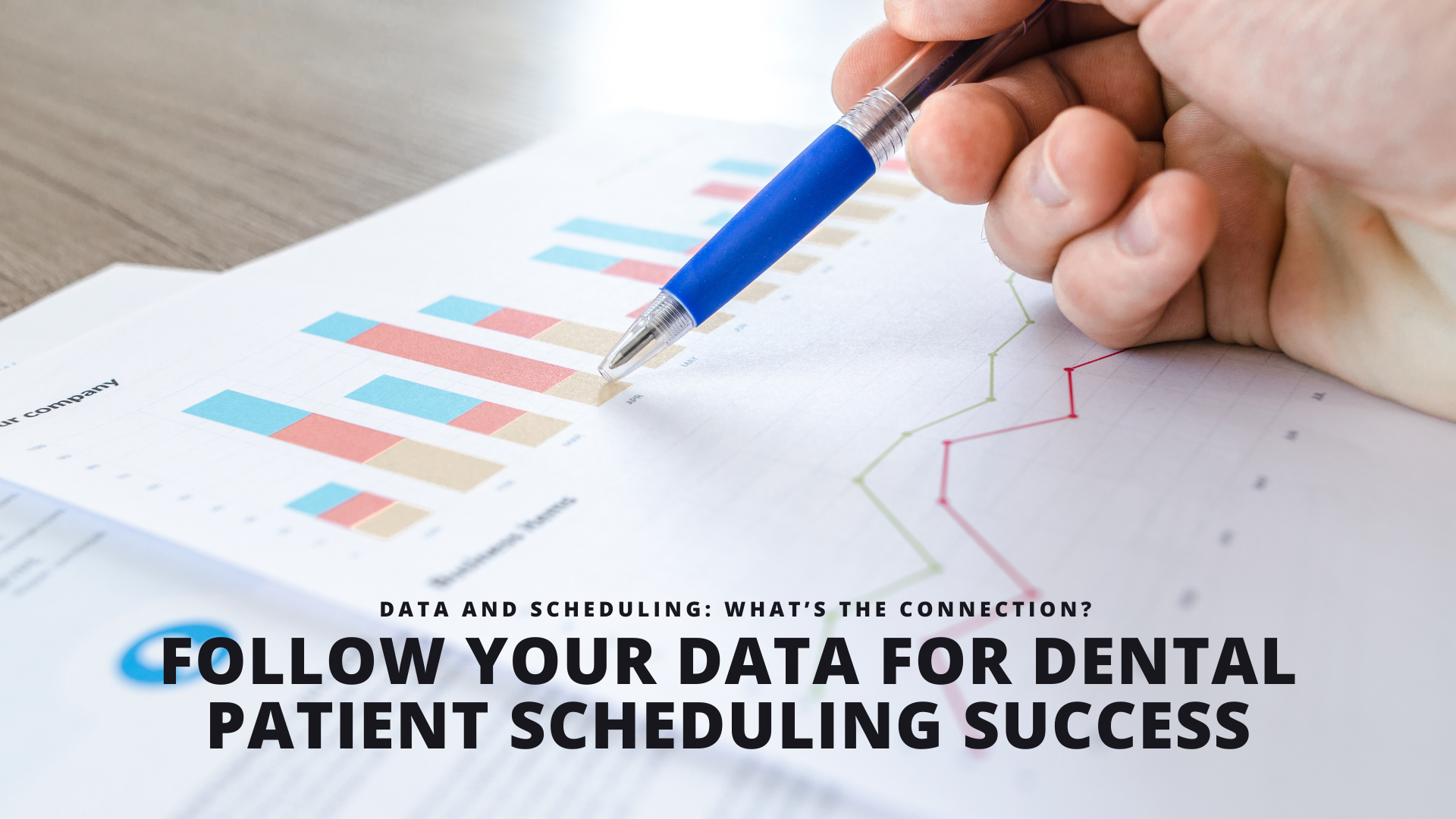Sure, we’re biased. But we understand the value of letting data lead the way. That would apply to how you strategize around dental patient scheduling.
Why data?
Well, for starters, it provides you with an accurate perspective on your progress to date. And that helps you chart your path for what’s next.
Data and scheduling: what’s the connection?
There are useful data connect points throughout your dental practice, group practice, or DSO. For example, data reveals where you have margin and where that margin is narrowing.
You understand the overhead challenges associated with dentistry. Factor in the insurance challenges, treatment write-offs, patient attrition, and more, and you’ll gain an understanding of tracking patient production.
That’s where your scheduling strategies come into play.
You’re likely scheduling according to average hourly production. It’s a good idea to explore your past and current data to determine how your scheduling system(s) are functioning before implementing new ones.
- Evaluate your scheduling process history (past and present) and related KPI numbers.
- Audit time factors. For example, look for scheduling-related data such as patient follow-up timing and the ROI of energy expended compared with follow-up results.
- Segment your appointment scheduling data. Evaluate re-appointments separate from patient reminders. Each has a unique impact on the scheduling to production path.
Follow your data and let your scheduling do its work
Create goal markers that measure your progress
It’s easy to react. You see holes in your scheduling process, and you seek a quick fix.
Before you leap into action, clarify where you want to be in terms of production. Hitting “pause” can also help your staff (and those tasked with scheduling) to catch their breath and train themselves to spot trends.
What trends?
Again, your data can give you insight into production to scheduling trends. Those trends can be observed on a daily, monthly, and annual timeline.
- Look back (where you’ve been) at scheduling trends.
- Look forward (where you want to be) and establish new daily, weekly, monthly, and annual goals for scheduled production.
This might sound simplistic. But you might also be amazed to discover how reactionary you/your team has been relative to dental patient scheduling goals.
Team-up around your scheduling goals
Production data reveals bottom-line success. But at what cost?
A stressed staff or patients who could feel pressured into treatment might reveal a different story.
- Design your morning huddles to include daily schedule data. It is not just who’s on deck but also why, their scheduling and treatment history, and the emotional connection they bring to their scheduled appointment.
- Train your team to recognize scheduling “triggers.” Again, a patient’s emotional reason for scheduling also carries weight alongside a pain or health motivation.
- Designate a scheduling point-person. “Point” in the sense that they are focused on the obvious and marginal data, and they can help spot and use trends to achieve new and current scheduling goals.
Make ongoing (and necessary) improvements to your scheduling workflows
The if-it’s-not-broken-why-fix-it mindset makes sense for the most part. But it can limit your scheduling potential if you stay content with the status quo.
Switch things up on occasion. For example, refine your scheduling blocks to improve your appointment and procedural efficiency. Also, review team member to appointment ratios (e.g. how many DAs and/or hygienists are available on a given day/scheduling block).
Monitor your time. A lot can impact time increments such as room prep, PPE change, hand-offs, etc. Again, look for trends that positively or negatively affect how you and your team use their time for patient care according to your schedule.
Develop a fair (but firm) cancellation and no-show policy and communicate it to your patients. Also, do as much schedule forecasting as possible. Rely on individual patient data, routine reminders, and patient appreciation to help reduce any broken appointment trends.
Your dental scheduling success will reflect the intentional and strategic energy you give to it. Start with your data and monitor it for the trends that can leverage new dental scheduling solutions.
Use data to your advantage as you work to fill your dental schedule with production.
The key is gathering available data, analyzing it, and creating scheduling strategies around your discoveries. But, of course, that requires a platform built for data analytics.
The following two resources will provide you useful insight into how data analytics gives you an advantage:
“Mine” Your Data for Unscheduled Dental Treatment and Increase Your Revenue
The Importance of Dental Dashboards and Dental Analytics
Refine your dental patient scheduling process with an all-in-one dental dashboard
The Jarvis Analytics platform helps assure that you’re tracking the important metrics and staying on track with your goals as your dental practice and/or DSO grows and expands.
Jarvis…
- Integrates seamlessly with your chosen practice management software/platform
- Presents the metrics you want and need in an easy-to-view dental dashboard that reduces data complexity for growing dental practices, dental groups, and DSOs
Experience Jarvis in action. Request a demo today!
Or…
Contact us for more information about data tracking that leads to profitability.
LIKE WHAT YOU SEE & READ?
Join thousands of other people, subscribe to our newsletter, and get valuable business tips delivered right to your inbox.


